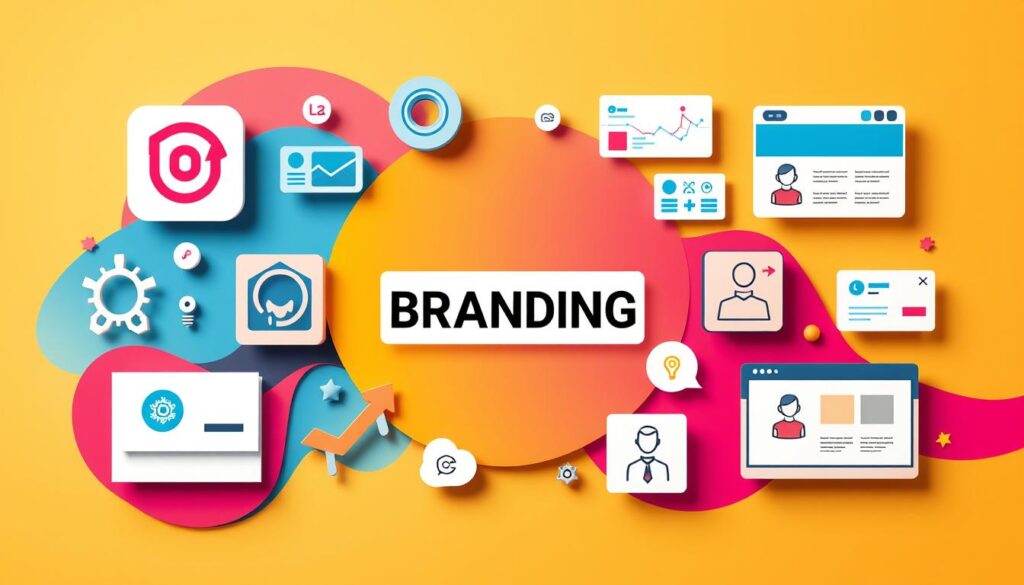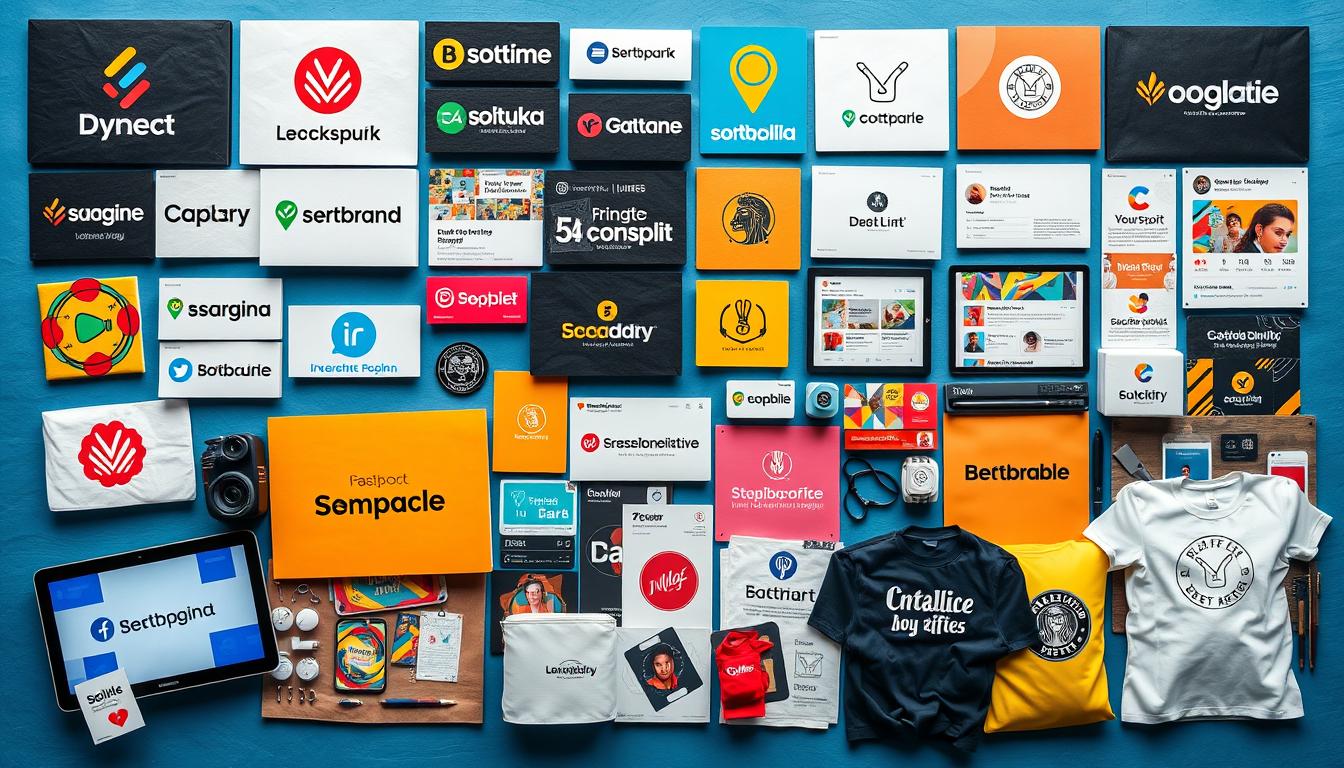Ever wondered why some pros seem to attract success easily? It’s often because of their personal branding. In today’s fast world, a strong personal brand can set you apart. This article shares inspiring examples and strategies from today’s top professionals.
It’s perfect for entrepreneurs, freelancers, and content creators. Learn how to use personal branding to achieve your goals.
Key Takeaways
- Personal branding is vital for standing out in competitive fields.
- Successful personal branding statements are often concise, ranging from 1 to 3 sentences.
- Incorporating industry-specific skills enhances uniqueness and credibility.
- Catchphrases or taglines can effectively market your personal brand.
- Building relationships with audiences and clients is integral to branding success.
- Personal interests can add a relatable touch to your professional identity.
- Consistent personal branding can open doors to new opportunities and collaborations.
Understanding Personal Branding
Personal branding is key in today’s job world. It lets people shape their identity and story to connect with others. Knowing about personal branding helps you build a strong image, opening doors to many chances. This part talks about what personal branding is and why it’s crucial for your career.
What is Personal Branding?
A personal brand is your story and how you show yourself to the world. It shows your special qualities and skills, making you memorable. Personal branding is about telling a story that shows who you are and what you offer, standing out in a crowded field.
The Importance of Personal Branding
The importance of personal branding is huge. A strong brand makes you credible, visible, and attracts the right opportunities. Influencers like Gary Vaynerchuk and Sara Blakely show how creating content can grow your audience. By focusing on a niche, you can build a strong brand identity. This helps you connect deeply with your audience, growing your influence.
Key Elements of a Strong Personal Brand
Building a strong personal brand means knowing key elements. These elements form the base of a unique and impactful brand. They help connect with your audience.
Your Unique Story
Telling your unique story creates emotional bonds with your audience. Your experiences make you relatable and authentic. Sharing your journey helps others trust and follow you.
Skills and Expertise
Knowing your skills and expertise is crucial. It shows what makes you stand out. Highlighting these skills helps you shine in your field.
Your Core Values
Core values show what you believe in and guide your actions. They help people understand you. Sharing your values attracts those who share your beliefs.
Visual Design
A strong visual identity makes your brand memorable. Colors, fonts, and logos should be consistent. A good design helps your brand stand out and be recognized easily.
Crafting a Personal Brand Statement
A clear personal brand statement is key. It tells your story, skills, and values. It guides your branding efforts and helps you communicate your value. Learn more about personal branding strategies here.

| Element | Description |
|---|---|
| Your Unique Story | Emotional connections through personal experiences. |
| Skills and Expertise | Highlighting unique capabilities that differentiate you. |
| Your Core Values | Guiding principles that inform your actions. |
| Visual Design | Cohesive identity that enhances recognition. |
| Personal Brand Statement | A concise articulation of your brand and value. |
Successful Personal Branding Strategies
Effective personal branding strategies are key for professionals wanting to boost their credibility and visibility. These strategies can greatly impact your career, opening doors to opportunities that match your skills and goals.
Building Credibility and Trust
Building credibility is vital for personal branding. Clear messages about your skills and what you offer help build trust in your field. By regularly engaging with your audience, you can improve your reputation.
Sharing your expertise through speaking or writing valuable content creates a strong connection. This is something that potential clients and employers highly value.
Enhancing Visibility and Opportunities
Being visible is crucial for personal branding. A strong personal brand helps you stand out in a crowded market. This can lead to great opportunities, boosting your earning potential and career growth.
Many successful people use their personal brands to attract partnerships and collaborations. This shows the power of a well-crafted image.
Gaining Control Over Your Narrative
Personal branding lets you shape how others see you. By carefully crafting your story, you can showcase your strengths and values. This way, you can influence public perception positively.
This control helps professionals align their branding with their career goals. It enhances their reputation and marketability.
Personal Branding Examples That Will Inspire You Today
Looking at personal branding case studies can really help you grow your brand. Here are some examples that show great strategies and stories.
Case Study: Tori Dunlap
Tori Dunlap is a financial expert who helps millennials with money and career advice. She shares valuable content that shows the power of being real. Her brand is all about being open, which makes her messages hit home with her followers.
Case Study: Aliza Kelly
Aliza Kelly is a well-known astrologer who makes her brand feel friendly and smart. She’s real on social media, which helps her connect with people. Her ability to relate to her audience makes her a top example in personal branding.
Case Study: Jay Clouse
Jay Clouse helps creators become independent, showing a strong brand across different platforms. He keeps his message clear and engages with his audience consistently. His work shows how personal branding can motivate and guide others.
Case Study: Tony Robbins
Tony Robbins is famous for helping people improve their lives. He uses engaging visuals and true stories to connect with his audience. His approach shows how personal branding can make a big impact, inspiring others to reach their goals.
Personal Branding Tips for Creating Your Own Brand
Building a strong personal brand is key to standing out in your career. It’s about defining who you are and what you offer to your industry. Here are important steps to create your own unique brand.
Identify Your Niche and Audience
Finding your niche is crucial in personal branding. Knowing your target market lets you tailor your message and offerings. This makes your brand more relatable and valuable.
Talking to professionals in similar fields can give you valuable insights. It helps you create a brand that truly resonates with your audience.
Use Authentic Storytelling
Authentic storytelling grabs people’s attention and builds connections. Sharing real stories, including personal experiences, shows your resilience and relatability. It draws people into your journey.
By sharing how you’ve overcome challenges, you show the unique value of your brand. Using platforms that focus on storytelling can boost your engagement and visibility.
Stay Consistent Across Platforms
Being consistent in your messaging and visuals across all platforms strengthens your brand. A unified personal brand makes it easier for people to recognize you and understand your values. This consistency builds trust and reinforces recognition.
Keeping your branding consistent ensures you communicate your expertise and authenticity well. For more tips on personal branding, check out this guide.

Personal Branding Techniques for Social Media Success
In today’s digital world, social media branding is key to building a personal brand. It helps you connect with your audience. Knowing how to use Instagram and TikTok, and creating engaging content, is crucial for success.
Leveraging Instagram and TikTok
Instagram and TikTok are great for personal branding, especially for creatives. They let you show your personality and skills through visuals. To make an impact, you should:
- Post high-quality visual content regularly to attract and retain followers.
- Engage with followers through comments and polls to build community.
- Use trending formats like Reels and TikTok challenges to reach more people.
- Make sure your content fits the platform’s audience but stays unique.
Creating Engaging Content
Creating content that grabs your audience’s attention is essential. Quality and visual appeal are important. To resonate with your audience, you should:
- Share personal stories, tutorials, and behind-the-scenes insights that add value.
- Post content consistently, ideally once a day on Instagram, and 1-5 times a day on X (formerly Twitter).
- Try video content, as it tends to get more engagement.
- Use feedback and metrics to improve your strategies.

| Platform | Optimal Posting Frequency | Content Type |
|---|---|---|
| Once daily | Mixed content (text, image, video) | |
| 1-2 times daily | High-quality images, stories, reels | |
| X (formerly Twitter) | 1-5 times daily | Short updates, engagement posts |
| 2-5 times weekly | Professional articles, achievements | |
| TikTok | 3-5 times weekly | Short videos, challenges, trends |
These strategies show how important personal branding is for a strong social media presence. Engaging with your audience and sharing valuable content are key to a successful personal brand online.
Common Mistakes to Avoid in Personal Branding
Building a strong personal brand takes careful thought. Many people make mistakes that hurt their growth and connection with others. By avoiding these errors, you can make your brand last longer and stay relevant in today’s world.
Inconsistent Messaging
Confusing messages can make people doubt your brand’s true nature. A CEO who pushed for better pay got a lot of media attention. This shows that being clear and consistent is key to building trust.
Make sure your personal and professional profiles match. This creates a strong, unified voice. Being consistent is crucial for a solid personal brand.
Neglecting Audience Engagement
Not talking to your audience can make them feel left out. Engaging with them is a powerful way to build a personal brand. By listening and talking back, you can win their loyalty and connection.
Only a small part of your social media followers might see your posts on their own. This highlights the need to actively engage with them. Being real in your communication is more valuable than using AI. People want to connect with real, relatable content.
Steering clear of these mistakes can help you build a lasting brand. For more tips on keeping your branding strong, check out this article.
| Mistake | Impact | Solution |
|---|---|---|
| Inconsistent Messaging | Confuses the audience | Align all brand components |
| Neglecting Audience Engagement | Creates a disconnect | Engage regularly and seek feedback |
| Lack of Authenticity | Reduced trust and relatability | Focus on genuine interactions |
| Overemphasis on Past Achievements | Limits growth and engagement | Continually provide value |
Conclusion
Success in personal branding is more than just being seen. It’s about telling a story that connects with your audience. Learning from Elon Musk and Gary Vaynerchuk shows us how to build a strong brand. Their stories highlight the power of storytelling, staying consistent, and being true to yourself.
For small business owners, adding personal touches to branding is key. It helps build loyalty in a crowded market. Using social media and creating interesting content can make your brand stand out. Learn more about branding strategies in this personal branding examples guide.
Creating a successful personal brand takes hard work and flexibility. As seen in many successful cases, combining visibility, engagement, and clear goals can lead to great opportunities. Personal branding is not just helpful; it’s crucial for professional growth.






